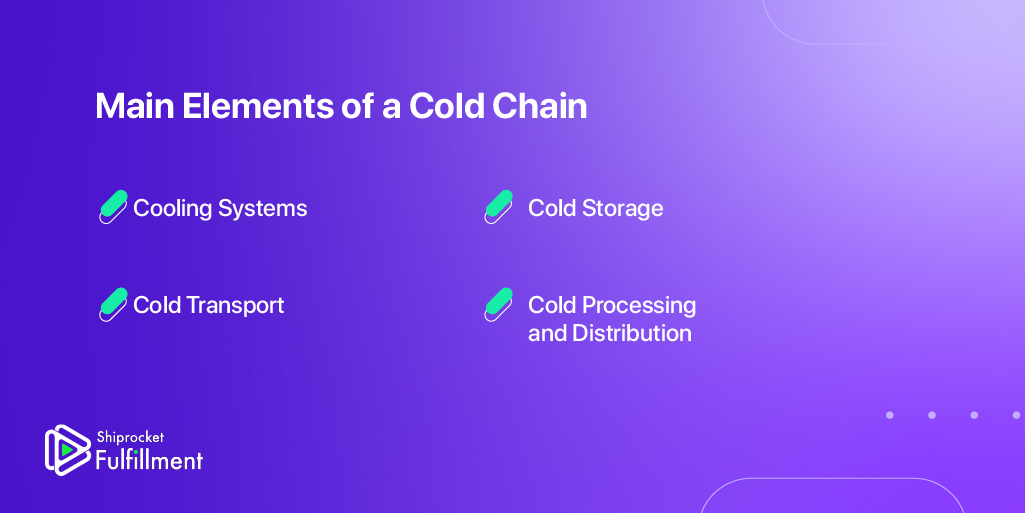Cold chain logistics revolves around the transportation of temperature-sensitive products and maintaining a supply chain through thermal and refrigerated packaging methods. A considerable amount of logistical planning goes into protecting these types of shipments.

What is Cold Chain Logistics?
Social media has made the world a global village and has made the relative distance between regions across the globe extremely slim. However, in reality, the physical separation of the same areas is humongous.
The more the physical distance, the more likely the shipment will get damaged. Therefore, it is necessary to understand the complexity of the operations involved.
Many goods get damaged by temperature variations and by shocks. Perishable food products quickly degrade with time, and not keeping them in a temperature-controlled environment can affect the quality of the products. Time and coordination of moving the products from one place to another are vital factors for food production. Each delay can have significant negative consequences if the temperature control is missed.
To ensure that the products are not damaged or compromised throughout the supply chain, businesses like medical and food companies primarily rely on the cold chain.
Cold chain products are transported in several ways: refrigerated trucks and railcars, refrigerated cargo ships, reefers, and air cargo.
Cold Chain: a Science, Technology, and a Process
It is a science requiring one to understand the chemical and biological processes linked with the products. It is a technology as it heavily relies on temperature control. And it is a process as a series of tasks need to be put in place to prepare, store, transport, and monitor temperature-sensitive products.
What are the Main Elements of a Cold Chain?

1. Cooling Systems
This helps maintain the appropriate temperature of food for storing and transporting the products.
2. Cold Storage
Keeping the goods stored at a nearby location for some time in a temperature-controlled environment for distribution.
3. Cold Transport
Having conveyances available to move goods and maintain stable temperatures to protect the products for the customers.
4. Cold Processing and Distribution
Providing facilities for the transformation and processing of goods and ensuring sanitary conditions.
How to Provide a Temperature-Controlled Environment?

Ensuring that a shipment will remain within the temperature range for an extended period depends mainly on the type of container used and the refrigeration method. Cargo refrigeration takes up approximately 20% of all energy consumed in cold chain logistics.
Other factors such as duration of transit, the size of the shipment, and the ambient or outside temperatures experienced are essential in deciding what type of packaging is required and the related level of energy consumption.
It varies from small insulated boxes that only require gel packs or dry ice to rolling containers to a reefer with its own refrigeration system.
The cold storage facility is the most commonly used in cold chain logistics. It can range from a single temperature-controlled room to large dedicated warehouse centers.
Shiprocket Fulfillment is one of the fulfillment providers that also provide cold storage facilities in their warehouses. You can now process your orders with 99% accuracy and deliver your products 3X faster to the customers with one-day and two-day delivery options.

Cold Chain Operations
To maintain shipment integrity, businesses need to move a shipment through the supply chain without any setbacks and manage the temperature to ensure shipment integrity. This process has several levels, including the shipment preparation to its final verification at the delivery point.
Shipment Preparation
One of the significant concerns in temperature conditioning and packaging is that the temperature should already be what it is needed to be. Primarily, the cold chain devices are designed to keep the temperature constant. So, if the temperature is not prepared in advance, it won’t perform adequately.
Modal Choice
Many factors come into play when the shipment is moved- distance, size, weight, and time restrictions of the product. The shorter distance is easier to manage as the delivery can be done via a van or a truck. However, a longer trip may require an airplane or a container ship.
Custom Procedures
Custom procedures can be a little tricky. Since the cold chain products are time-sensitive, they are subject to more inspection than regular freight (e.g. produce, pharmaceuticals, and biological samples). The level of difficulty in this differs on the nation and the gateway since there are variations in procedures and delays.
Customs issues must be handled as they are crucial in establishing successful and reliable cold chains.
The Last Mile
The final stage is delivering the destination to its destination and in logistics, it is also called the ‘last mile’. It is key to keep in mind the delivery timing so the required space for warehousing is made available.
Trucks and vans, the primary modes of transportation for this stage, must meet the specifications necessary to transfer the cold chain shipment.
Integrity & Quality Assurance
After delivering the shipment, temperature recording devices help understand if there are any temperature anomalies or not. This process builds the foundation for trust and accountability.
Therefore, the setting and operation of cold chains depend on the concerned supply chains. Each shipment has different requirements in location, demand, level of concentration, load integrity, and transport integrity.






